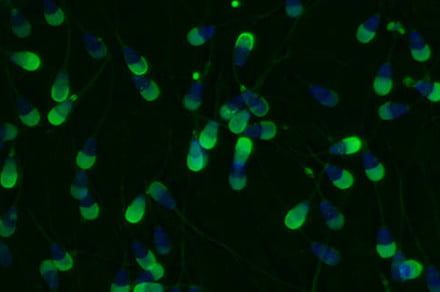“Do sperm squirm the same in space?” Forget birds and bees — NASA’s California Ames Research Center wants to know if human sperm measures up to bull sperm in space, and Elon Musk’s SpaceX is helping.
The sperm squirm project is called “Micro-11,” a missed opportunity for space science chuckles.
On April 2, 2018, NASA launched freeze-dried samples of human and bull sperm on SpaceX CRS-14, the transport company’s fourteenth cargo resupply mission. The giant rocket blasted off from Cape Canaveral for the approximately 41-hour flight to the International Space Station (ISS).
You can watch the bull and human sperm being launched in the SpaceX video below — no need for concern about the video rating, despite the transport company’s name.
[youtube https://www.youtube.com/watch?v=BPQHG-LevZM?feature=oembed&w=100&h=100]
NASA plans to compare male reproductive material from the two mammals to see how human sperm measures up to bull matter — additional fodder for a catchy project name.
Why test sperm from both humans and bulls? It makes sense to study the effects of space travel and reduced gravity on human reproductive health, but what about bulls? Is NASA considering suiting up astronaut bulls for bovine booty calls in space?
It turns out bull ejaculate scores higher on motion consistency than human sperm, which is often varied. As a side note, NASA’s news release is mum on testing male commitment in space. No such tests have been successful on earth.
All hands busy at NASA’s Kennedy Space Center preparing sperm samples for launch to the International Space Station. NASA
Sperm needs to be activated to start swimming when it arrives on site, in space and on Earth. With no species imperative-style activation, sperm squirms around randomly, possibly trying to answer a call for a smoke.
To kick off the reproductive process, deposited sperm must start swimming faster toward an egg and then fuse with the egg’s surface. While a sperm cell swims, its membrane has to become more fluid to facilitate fusion.
In earlier experiments with bull sperm and sea urchins, astronauts discovered swimming activation happened faster in space’s microgravity than on Earth, so that’s a good thing, disregarding any concerns about premature activation. In the same tests, however, the pre-fusion membrane fluidity changes were slower up there than on Earth, if they occurred at all. So the sperm got busy faster but often swam with no final purpose.
Sea urchins aren’t mammals, but they set a high bar for reproductive excitement and commitment. The prickly ocean creatures turn themselves inside out like socks as the respective genders release clouds of sperm and eggs.
[youtube https://www.youtube.com/watch?v=ak2xqH5h0YY?feature=oembed&w=100&h=100]
At the International Space Station lab, the crew will thaw the bull and human sperm samples, add chemicals to trigger activation and fusion, and record the activity on video. The samples will then be preserved and shipped back to the Ames Research Center, where scientists will analyze the results of the microgravity hookups and compare them with similar tests on Earth.
Editors’ Recommendations
- Prolonged time in space literally changes the structure of astronauts’ eyes
- Watch NASA test fire a giant rocket engine for its mighty Space Launch System
- SpaceX is blazing a trail to Mars, one milestone at a time
- NASA delays James Webb Space Telescope, pushes launch to 2020
- SpaceX nails another mission, sends a used Falcon 9 rocket to resupply the ISS

